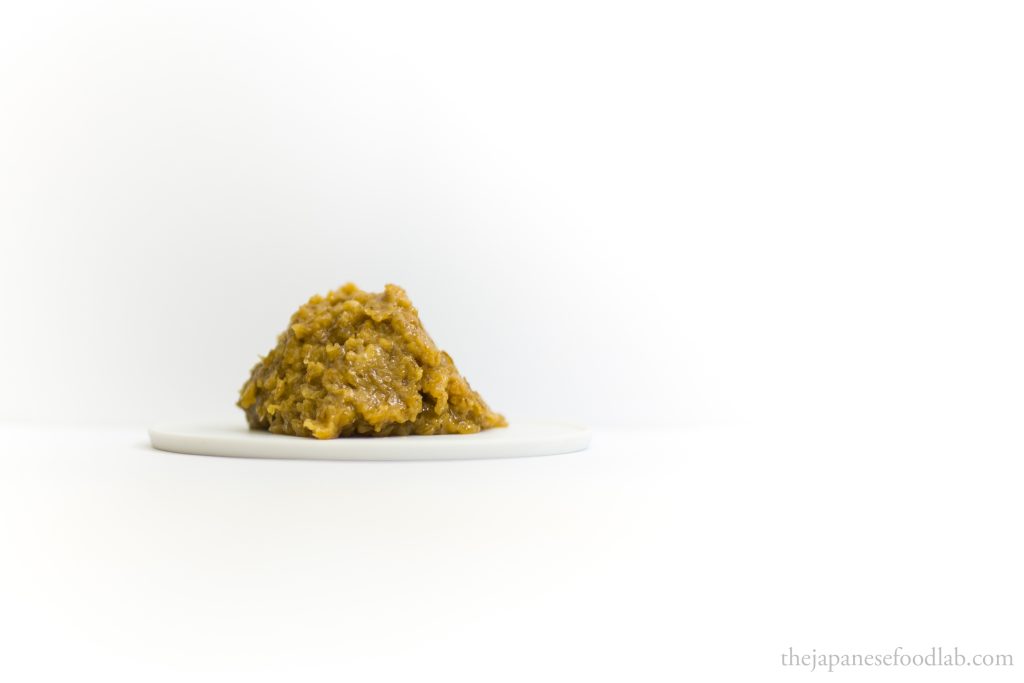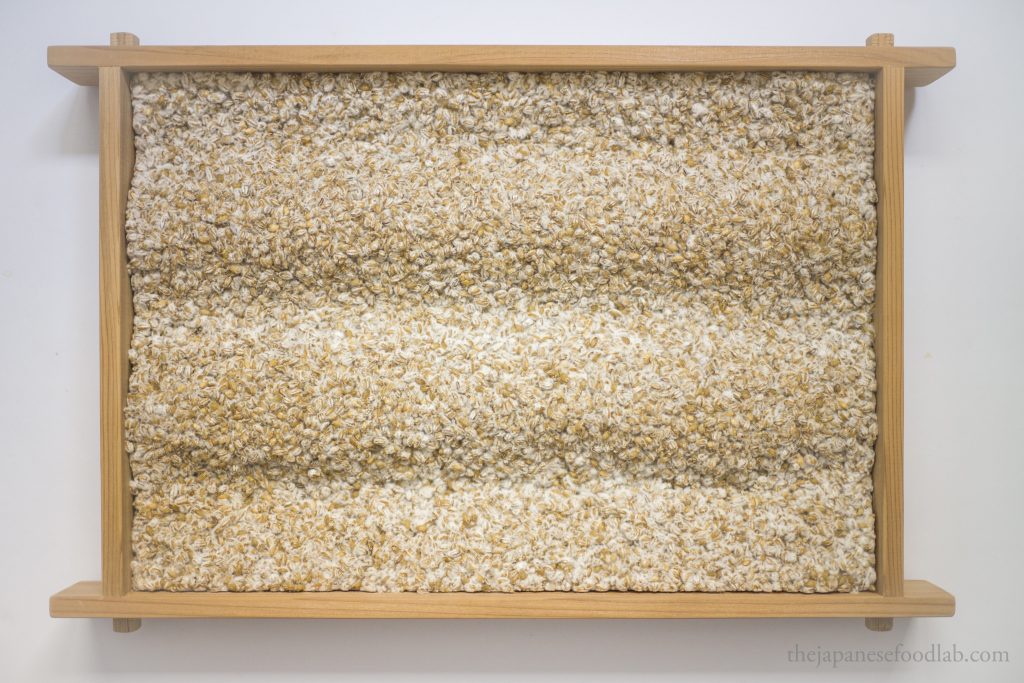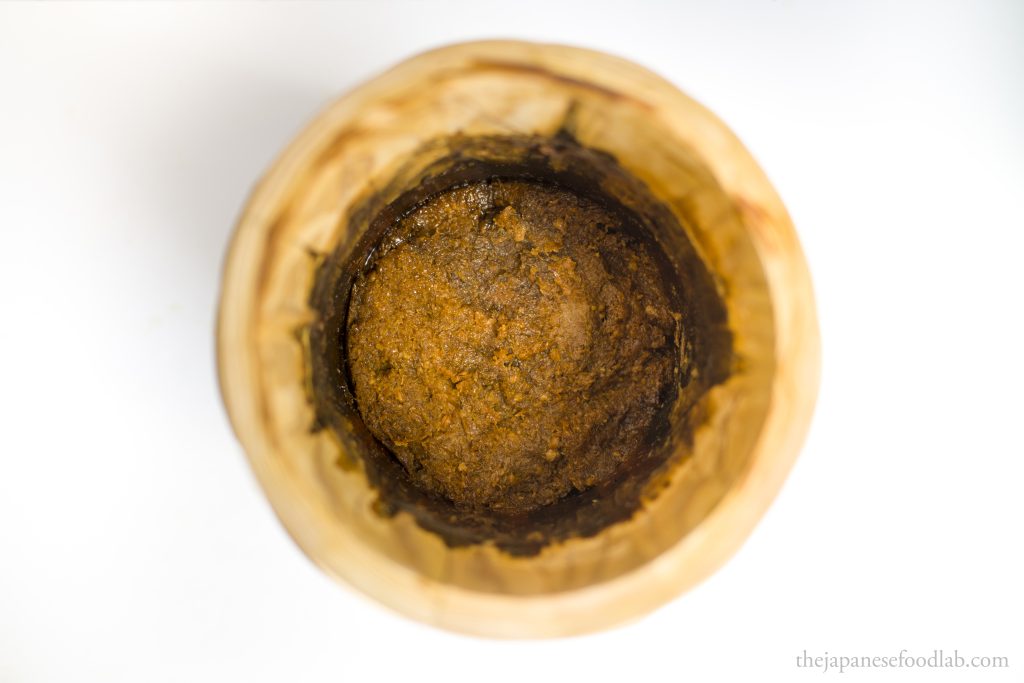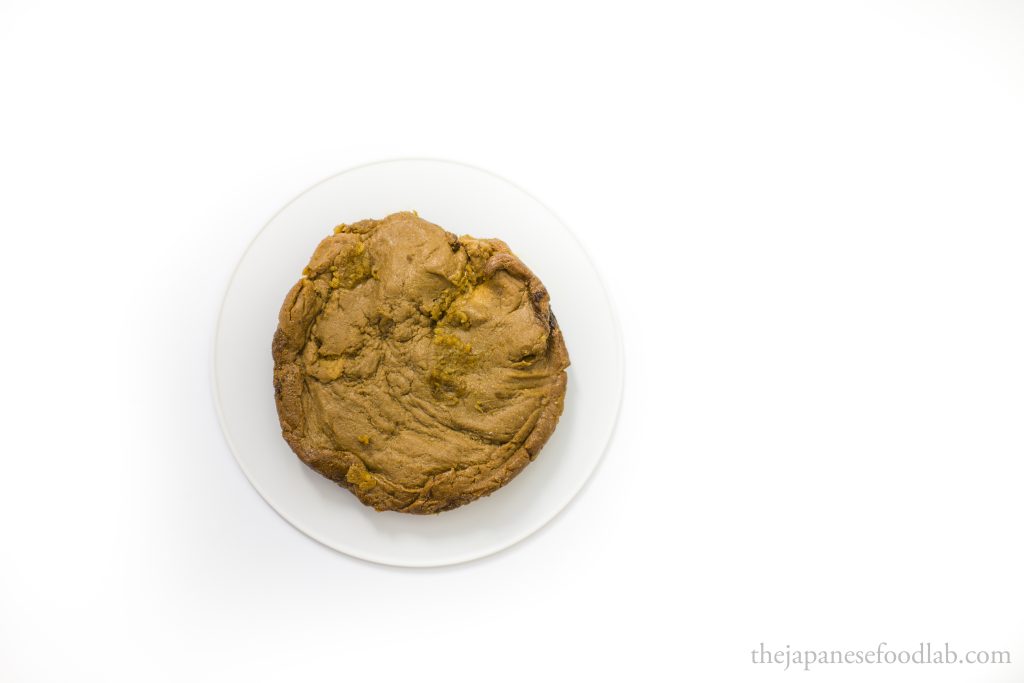*Read more about traditional vs modern miso. Otherwise you might be interested in the science of miso. This recipe uses the one for red miso (赤味噌) as a base as thus is a good read as a primer for this recipe.

Barley miso can be found throughout Japan but is still the most popular in Kyushu, the most southerly of Japan’s four largest islands. This miso is one we’d recommend if you’re keen on trying traditional long ageing, high salt content miso. We’ve had plenty of success with this recipe and it is one of our favourites, especially this variation with a high barley koji content.
The taste of this miso is slightly different from most misos made from rice koji as it’s made from barley koji and thus you can really taste the nuttiness from the barley. The barley koji also gives it a more robust and earthy taste that really stands up well to the addition of other ingredients. Therefore, we enjoy having it in soups or stews with other ingredients added, especially root vegetables.
Take note, because it’s designed for long ageing, it has a very high salt content. This means that the miso is going to be inedible for quite a long time as it’ll be extremely salty for many months until the taste of the salt mellows up with time. Please see the ingredient preparation section for fermentation timings.
Equipment Preparation
Please read the equipment preparation and ingredient preparation section for red miso (赤味噌) as a primer.

Ingredient Preparation
The ingredients we need and their corresponding amounts to make miso from 1kg of cooked soybeans are:
These values are given based on a two assumptions given below:
- We’re assuming that soybeans roughly doubled in weight when cooked. This is not always true so always weigh out your soybeans after cooking. When buying dried soybeans to make miso, a good rule of thumb is that soybeans at a minimum double in weight when cooked so you only need to buy half the weight in soybeans listed in this table.
- When using fresh koji instead of dried koji, you need to multiply the amount by 1.144.
- Because fresh koji has more moisture than dried koji, we only use 60% of the mixing liquid compared to dried koji.
The main emphasis here is to use barley koji instead of rice koji, which may be harder to find. Instead you can grow your own using the instructions here.
The recipe above yields 2155g of miso if using fresh koji and the minimum amount of salt, or 2345g of miso if using dried koji (also with the minimum level of salt, 175g). It is the minimum amount of miso that we are confident in recommending you try out making. Any less and the resulting miso can be slightly unreliable.
Ageing times for based on salt ratios
As you can see from the table above, the higher the amount of salt, the longer the miso needs to age before it becomes palatable. This is because the taste of salt slowly mellows out with time, so a miso that would taste overly salty at 8 months might taste just right after a year. The ageing times given above are just an estimate for a non-controlled fermentation environment. However, as there are so many variables to take into account such as differences in humidity, temperature and surface area, we recommend tasting your miso every few months to judge for yourself.
The bare minimum we let this miso ferment for in a non-temperature controlled environment is 8 months including a period of one summer in that 8 months, though we really think the miso is at its prime after 1.5 to 2 years, especially when you’re using a higher salt content. We also recommend starting to consume your miso before it’s prime so that you can learn to appreciate how the miso develops as it ages, and sometimes more interesting, how it declines after it’s prime.
If using a temperature controlled fermentation temperature, ferment at 27°C/81°F for 6 months before beginning tasting the miso. It ferments roughly twice as fast at this temperature.

Traditional Barley Miso Recipe (麦味噌の作り方)
A day before making the miso, you’d want to give the beans a quick wash in water before soaking them in at least twice their volume of water. You want to soak your soybeans for at least 12 hours at a minimum. If soaking overnight or more than 12 hours, soak the soybeans in the fridge. You’ll know the beans have finished soaking if when you split them in half, the inside of the halves are flat and not curved inwards. If using a wooden barrel to ferment your miso, we’d also recommend filling it up with water overnight to make sure the wood fully expands and seals up any gaps that may have appeared.
After soaking the soybeans, you can cook them in one of two ways. The first is to boil them in a large pot of water for 4 to 5 hours. You’ll want to have plenty of water covering the soybeans as if too much water evaporates, the soybeans at the bottom of the pot will start to burn, giving your miso a burnt taste. Boil the soybeans in the same water used to soak them. Start on high heat to bring the pot of soybeans to a simmer. Once simmering, turn down the heat to maintain a simmer with the lid on and simmer for 4 hours. As it’s coming up to a simmer, skim away any scum or foam that forms as this will cause the pot to bubble and overflow. You’ll want to skim the pot occasionally to stop this from happening whilst also checking that not too much water has evaporated. If the water level looks too low add in some more boiling water. At the 4 hour mark, check if the beans can easily be crushed between two fingers, if not, continue cooking the beans and checking every 15 minutes until they’re done. If using an instant pressure cooker, you’ll want to cook them for 25 to 27 minutes on high pressure after the water starts boiling/the pressure has built. We then recommend a natural release of pressure compared to a manual release as it keeps more flavour in the beans. If using a commercial pressure cooker with a gauge, you’d want to cook the beans at 15psi/1bar for 25 minutes or at 10psi/0.75bar for 30 minutes and then allow a natural release of pressure.
After cooking the soybeans, it’s extremely important to allow the soybeans to completely cool to room temperature before proceeding to the next step, or at least 40°C/104°F. Drain the soybeans from their cooking liquid but reserve the cooking liquid. The soybean cooking liquid will be used at a later step. Weight out the soybeans so that you have the amount specified in the recipe (Checkpoint! Make sure you’re weighing out the cooked soybean weight, not the dried soybean weight). Grind 60% of the weighed soybeans to your desired level and mix together with the remaining 40% of soybeans.
In a large mixing bowl or pot, weigh out the required soybean cooking liquid (Checkpoint! Make sure you adjust the weight of the mixing liquid depending if you’re using fresh koji vs dried koji). If there’s not enough soybean cooking liquid left, make up the weight with room temperature boiled water. Alternatively, if you are choosing not to use the soybean cooking liquid, weight out room temperature boiled water as the mixing liquid. Dissolve the salt into the mixing liquid but reserve some to sprinkle and the bottom of the fermentation vessel later. Next, mix in the seed miso if using.
Using your hands, crumble up your koji into grains as best as you can and then stir it into the mixing bowl (Checkpoint! Make sure you’ve adjusted the koji weight for dried vs fresh koji). Add in all the soybeans and mix together. This is the part where you’d want to get really hands on. Feel free to wash your hands and crush, squeeze and mix up the miso by hand (use gloves if you want to be 100% safe). This is a good point to check the moisture of your miso; it should have a consistency similar to store bought miso.

In your fermentation vessel, sprinkle some salt at the bottom of the vessel and rub some salt along the sides of the wall. Pack the miso into your fermentation vessel as tightly as possible, pressing it down using your hands or the back of a spoon to make sure as much air is pressed out of it as possible. Sprinkle some salt over the top and then cover with your inner layer of choice. In the images below, we use a layer of sake lees to directly cover the miso, followed by some plastic wrap. Wipe the remaining exposed inner walls of the container clean now as they’re the easiest part to grow mouldy. If you have some sake or shochu lying around, we recommend using a paper towel with sake to wipe down the walls. Add on the fermentation weights on top of your inner lid before covering the top of the container with cheesecloth or muslin cloth tied down with string or large rubber bands. If you don’t notice any liquid tamari being pressed out of the miso collecting in the top layer after 4 to 5 weeks, you’ll probably need to increase the amount of weight on the miso. If there is too much tamari being pressed out, remove the tamari to use as a soy sauce substitute and then reduce the amount of weight on the miso. Finally, be sure to note down the day you made the miso as well as the type of miso you’re making so that you can keep track of it.
If fermenting naturally, choose a spot that is not exposed to the elements, is not under direct sunlight, but most importantly has good ventilation. If using a wooden fermentation container, you’ll want the bottom of the container to be lifted slightly off the floor, either on a wire cooling rack or in between two pieces of wood or brick. For fermentation times, read the section above. It’s worth tasting the miso every few months after the first 6 months to understand the evolution of its flavour. When tasting the miso, peel back your inner lid, make a hole and scope out some miso from the inside to taste. Remember to press and flatten out the miso into an even layer before replacing the lid. Don’t unnecessarily expose the fermenting miso to the outside, so there’s no need to dig extremely deep or completely remove the whole inner lid.
For fermentation times, refer to the table above.
Nagasaki TB hospital used Miso to protect patients from Atom Bomb radiation. All patients survived one mile from ground zero. Miso was used in Japan to stretch food supplies.
https://hvparent.com/dr-akizukis-miso-soup-and-the-atomic-bomb
https://pmc.ncbi.nlm.nih.gov/articles/PMC3695331/
How to make Miso from any Grain, food waste, etc. Student tutorial? 4H + FFA?
Pumpkin seeds, spirulina algae, barley, beans and corn.
https://www.youtube.com/watch?v=qADkUWJFIAI
https://www.youtube.com/watch?v=yw3sHkFIet8
Could spent barley mash from beer brewery be used for miso?
Could Miso change GLP-1 receptors in Vagus nerve? Reducing diabetes?
I’ve left a reply in comments below 🙂
I’ve been looking at beermash in a contained system – and yes any grain or pulse which is part of what I’ve been looking at. I’ve seen some research projects that seem to be trying to reinvent the wheel on inoculating barley for brewing purposes without acknowledging centuries if not millennia of cultural (pun intended) practices around fermentation in Japan with Koji, or commercial research from Norway which has been pursued for decades in a more normal way.
Miso, tamari and Koji powder are already three products in one. Using beermash is very in keeping with the zero waste attitude – 85% of people want to prevent food waste, but only 60% want to eat it (part of my discussion) https://www.upcycledfood.org/
Miso is also the process behind tamari and perpetuating Koji powder, so three products in one already. So using beermash from a zero waste perspective is also in keeping with traditional processes. 95% of people want to reduce food waste and 60% want to buy more upcycled food products ( https://www.upcycledfood.org/ ). Most food waste happens in production, retail and consumer waste. Miso has it sorted, as do most traditional processes.
MAD trialed spent grain inoculation for miso with Momofuku in 2015:
https://www.copymethat.com/r/P1OMfncDO/a-brief-guide-to-making-koji-and-miso-fr/?is_macua_ios=1